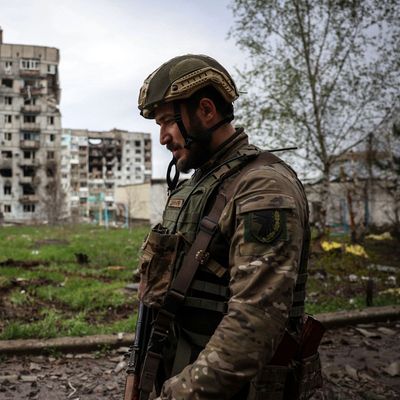
The Battle of Bakhmut is among the most appalling events of Russia’s grotesque war on Ukraine. The city is of relatively little military significance, and for both armies, the bloodshed there in the past few months has been less of a means than an end: Russia and Ukraine have each sought to tie up the other’s army in Bakhmut and thin its ranks ahead of higher-stakes conflicts to come. In fighting for control of the city it destroyed, Russia has been especially unprecious about its own soldiers’ lives, using wave after wave of recruited prisoners as cannon fodder. The battle has already killed and maimed well over 100,000 human beings while displacing virtually all of the city’s 70,000 residents. And it’s not over. Volodymyr Zelenskyy’s government said on Sunday that Bakhmut was “not occupied” by the Russian army and that Ukrainian forces were advancing in its suburbs.
It is conceivable that Ukraine’s impending counteroffensive will fundamentally change the shape of the war. Perhaps an escalation in the quantity and quality of western aid will remake the balance of power and enable Ukraine to reconquer the entirety of its rightful territory.
But that scenario is improbable. For Ukraine to win a total victory, Russia would need to lose the economic wherewithal, political will, or manpower to keep up the fight. And there’s little sign that Vladimir Putin is running short on any of those fronts.
Western sanctions have bent but not broken the Russian economy, which is poised to grow by more than one percent this year. This partly reflects the commercial weight of pro-Russian and neutral nations. Thanks to Chinese and Indian demand, Russian oil exports have returned to pre-invasion levels.
Putin’s political position appears similarly secure. Many western observers hoped Russia’s mass conscription last September would trigger a destabilizing opposition to the war. But it might have had the opposite effect: By chasing hundreds of thousands of the most internationally mobile (and thus disproportionately liberal) Russians out of the country, the mobilization might actually have weakened Putin’s domestic opposition. In any case, wartime mobilization has enabled the Russian dictator to rationalize heightened repression. In recent days, Russian authorities raided the opposition news outlet Meduza, while Duma deputies prepared a bill that would make expressions of “Russophobia” punishable by up to five years in prison. At the same time, the Kremlin has managed to concentrate the burdens of conscription on the most disempowered parts of Russian society, such as ethnic minorities in provinces far from Moscow and St. Petersburg.
The lack of effective resistance to mass conscription means Moscow has no shortage of manpower. The war has degraded the quality of Russia’s soldiers but done little to dent their quantity. Russia is three times as populous as Ukraine. It commands a total military force of 1.3 million people and has millions of additional military-age men at its theoretical disposal. By contrast, the Ukrainian military’s head count is closer to 500,000.
Combine these background realities with the relative stability of Russia’s territorial gains in recent months and it is difficult to give Ukraine very high odds of full victory. For its part, Ukraine remains well funded and determined to liberate its territory. A poll of the Ukrainian public taken earlier this year found overwhelming opposition to making territorial concessions in exchange for peace. The overwhelming likelihood is that Ukraine and Russia will fight to a stalemate along some as yet undetermined (perhaps ever-shifting) line. At least this is the consensus view among analysts of the conflict, from chairman of the Joint Chiefs of Staff Mark Milley to the RAND Corporation to Russian historian Stephen Kotkin.
Not all stalemates are created equal, however. A military deadlock could lead to a negotiated settlement of the conflict, or it could lead to a prolonged war of attrition — which is to say, to Bakhmut on a grander scale.
The Biden administration is rightly averse to the latter scenario. Yet it is also understandably pessimistic about the prospects for a negotiated peace anytime soon. Thus, in recent days, White House officials have given heightened attention to a third outcome: a “frozen conflict” in which Russia and Ukraine agree to stop shooting without formally making peace, akin to the situation on the Korean Peninsula and in the disputed region of Kashmir.
Such a scenario is a bit easier to imagine in the near term than a negotiated settlement, and it would certainly be less damaging than a yearslong war of attrition. But getting to a “frozen conflict” would still be a profound diplomatic and military challenge and would come with significant costs for Ukraine.
The United States has both humanitarian and strategic interests in averting a war of attrition in Ukraine. Such a conflict would extinguish life at a massive scale while immiserating ordinary Ukrainians, who have already seen their nation’s economy contract by more than 30 percent while much of its infrastructure has been destroyed. Strategically, there is reason to fear that Russia may have the upper hand in a test of endurance, owing to both its manpower advantage and the fact that perpetual war would impose far steeper costs on Ukrainian civilians than on Russian ones.
More broadly, defeating the Russian invasion is not the U.S.’s only pressing geopolitical interest. From the standpoint of both the country’s economic prosperity and global power, a Chinese conquest of Taiwan would be far more menacing than a Russian annexation of the Donbas, and the war in Ukraine is consuming resources the U.S. would otherwise direct toward Taiwan’s defense. Washington has already expended 13 years’ worth of Stinger anti-aircraft missiles and five years’ worth of Javelins on the Ukrainian cause, forcing a delay of arms shipments to Taiwan. A January report from the Center for Strategic and International Studies estimated the U.S. would exhaust its supply of long-range, precision-guided munitions within the first week of a war in the Taiwan Strait.
The Korean precedent looms especially large in U.S. war planners’ imaginations. Active fighting between North and South Korea ended in 1953, yet the war officially continues to this day. As one former Biden-administration official told Politico, “a Korea-style stoppage” is “plausible, because neither side would need to recognize any new borders and the only thing that would have to be agreed is to stop shooting along a set line.”
The former official was candid about the appeal of such a cease-fire from Washington’s perspective, saying, “It’s cheaper to arm a country that isn’t expending the weapons every day.”
Still, the path to a frozen conflict is far from clear. Freeing Zelenskyy from the obligation of recognizing a revision of Ukraine’s borders may make it marginally easier for him to sell his public on leaving many Ukrainians under indefinite Russian occupation. At the same time, in a frozen-conflict scenario, Russia would not even officially disavow an intention to rearm and resume its bid for reconquest at a later date; indeed, its official position would more or less affirm that intention. And this could make a cease-fire even less palatable to Kyiv, which is understandably averse to giving its more populous and powerful would-be conqueror the opportunity to regroup.
In the Korean context, peace in the demilitarized zone was underwritten by the presence of thousands of U.S. troops. No such deployment is foreseeable in Ukraine. It is possible the West could reconcile Kyiv to a cease-fire by extending either NATO membership or de facto Article Five protection, yet it’s far from clear that the U.S. and its allies are prepared to assume that obligation. Before the current conflict, when the prospect of a full-scale Russian invasion of Ukraine seemed far-fetched, the U.S. and Europe were already reluctant to extend NATO protection to Ukraine for fear of ending up in a direct military confrontation with a nuclear superpower. The notion that the U.S. would be more comfortable committing to Ukraine’s defense in a context in which Kyiv is still officially at war with Russia also seems far-fetched. In all likelihood, the West will offer Ukraine an arrangement akin to that between the U.S. and Israel, with NATO members providing open-ended military aid and training to Kyiv but no true security guarantee.
In any event, the more satisfying the proposed security arrangement is to Ukraine, the less palatable it will be to Putin. If Ukraine could be won to a cease-fire with a promise of NATO membership, that same gesture would likely dissuade Russia from putting down its arms. After all, to the extent that Putin’s war has any rational basis, it is to prevent Ukraine from aligning militarily with the West. And Putin has more reason to fear a western-aligned Ukraine today than he did before his invasion. Relative to February 2022, the West is more hostile to his regime, his military is less powerful, and NATO is larger and more unified.
Similarly, any shift in territorial control that renders Ukraine more disposed to accept a cease-fire — such as a hypothetical liberation of Mariupol — would be liable to have the opposite effect on Russia.
In some respects, a frozen conflict would be even more painful for both sides than a negotiated settlement. It is conceivable that Russia could win a degree of sanctions relief from a comprehensive peace agreement, but there is no prospect of the West providing economic relief to a Russian state that remains officially committed to an invasion.
For Ukraine, meanwhile, rebuilding its economy once the fighting has ceased will be a Herculean task in any scenario. The World Bank recently estimated the cost of reconstructing Ukraine at $411 billion in March, a figure that has only risen in the intervening months. In addition to the devastated infrastructure, land mines now cover nearly a third of Ukraine’s territory. Removing those will be both incredibly expensive and indispensable for providing Ukrainians with some semblance of normal life. A frozen conflict could compound these economic challenges by discouraging private investment in Ukraine in light of its ongoing geopolitical vulnerability.
Avoiding a yearslong parade of Bakhmuts — in which hundreds of thousands are killed or maimed for the sake of moving a map line a few miles in either direction — is a humanitarian imperative. Providing postwar Ukraine with a modicum of geopolitical security and economic prosperity is too. But reconciling the demands of peace and justice remains difficult. One must hope the Biden administration’s vision for achieving a frozen conflict is more detailed and coherent than the murmurings that have made it into earshot of the press.






























